A Headless Body Production
Venue: An Undisclosed Basement
Event: Playing a game for the camera , Early December, 2020
Players: Phil Gardocki running Classical Greek
Tom Worden running Late Imperial Roman
Game System: L'Art de la Guerre, 15mm, 200 points per side.
The Forces:
Classical Greek(list 235)
3 Ordinary Commanders, Lavrentios, Davrentios and Davrentios.
18 Hoplites, Heavy Spearmen, 2 are Elite
6 Peltasts and Thracians, as Javelinmen
2 Cretans, Light Infantry, Bow
2 Slingers
Breakpoint of 28
Late Imperial Roman (List 86)
3 Ordinary Commanders, 2 Included in their respective cohorts.
8 Legionaries, Heavy Swordsmen, Impact, Armor, 2 are Elite
2 Auxilia Palatina, Medium Swordsmen, Impact, Elite
2 Cretans, Light Infantry Bow
2 Medium Artillery
2 Cataphracts, Elite
2 Equites, Heavy Cavalry, Impact
2 Equites Sagittarii, Light Cavalry, Bow
Breakpoint of 21
Conventions:
When you see a word bubble "Ouch!", "Heus!", "Ωχ!", this
implies a disorder hit from missiles. Letters in parenthesis represent some
value change for the specific unit. For commanders it is s for
strategist, b for Brilliant, c for Competent and o for Ordinary, u for
unreliable. For troops it is e for Elite, and m for Mediocre. Other
abbreviations, Hvy Heavy, XB Crossbow, LB, Longbow, Jav Javelin, 2HW 2
Handed Weapons, B Bow, Kn Knight, HKn Heavy Knight, HC Heavy Cavalry, Md
Medium, Sgt Sergeants, LC Light Cavalry, Chr Chariot, Cat Cataphract,
Pa Pavise, LI, Light Infantry, HG Hand Gun, FKn Foot Knight, Hvy Spear,
Heavy Spearmen.
"XX" implies a unit killed in that location on that turn.
I am experimenting with maximum sized armies, trimming points where ever possible. This was heavily influenced by podcasts put out by Tim Porter, the Mad AxeMan. He invited his crew to come up with practical Hoplite armies that can actually win on the table. Most stressed mediocre troops and some included commanders, and got armies out there with 18 or more Hoplites and breakpoints over 25. His podcasts can be found here!
Heavy Spearmen are the Orcs of the game. Sure they are good against cavalry, which will then just drive on by onto the flanks. And they lose to Impact, Impetuous, Armored or 2HW infantry. Just about everyone. But 18 of them? With 6 ok supporting units. With a single piece of terrain on the edge, they don't have a flank to go around. You will have to go through them. No matter where you are, they will be there. Meanwhile, they will be finding your flanks, because they will be wider than you.
So I am breaking away from my smallish, but elite armies to give it a try. This list has 18 Hoplites, 6 Javelinmen, and 4 Skirmishers for a size of 28. By another measure, 90 cohesion hits. But the commanders are included and vulnerable, and when you commit to combat you have to commit big, because you will not have command points for anything else.
Losing a commander or two, as well as the camp, is not an option with this army, but a requirement! If I lose them all, that is only 13 points out of 28! I would like to see Scipio Africanis take that kind of damage.
But Tommy is also listening to the same podcasts, and his armies, while still armoring up and elited, also have included commanders as well, in an attempt to match the numbers.
The Board:
 |
By the serene River Marista, mayhem was brewing.
|
 |
Legions from Rome continue their conquest of Ancient Greece
|
 |
But the city states are brave and field their citizens in mass.
|
 |
Led by Lavrentios, and his brother, Davrentios.
|
 |
| And his other brother Davrentios. |
Turn 1: |
Though postured to attack, the Roman legions remain motionless.
|
 |
Their goal is to let their catapults do the work.
|
 |
While their incredibly well armored cavalry seek a flank.
|
 |
The Greek military science is precise. To be wider and deeper than your foe, and victory will follow.
|
 |
It's a scientific theory that has not been proven against the Romans.
|
 |
But seeking higher ground is also a good idea.
|
Turn 2: |
On the second bound, the order is given to advance.
|
 |
In perfect synchronization, heavy-soled hobnailed military sandals beat a steady staccato in the hardened clay.
|
 |
The Roman horse halts and extends their lines.
|
 |
The Hoplite force slides to the right, but maintains an overlap on the Roman main battle line.
|
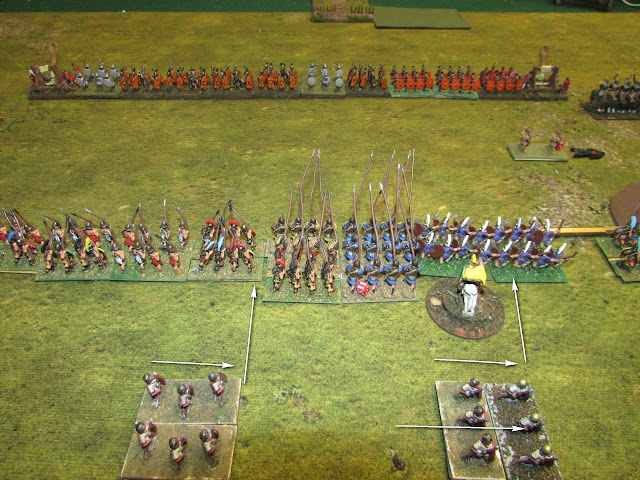 |
The centers reserve Peltasts take up position to plug potential holes in the line.
|
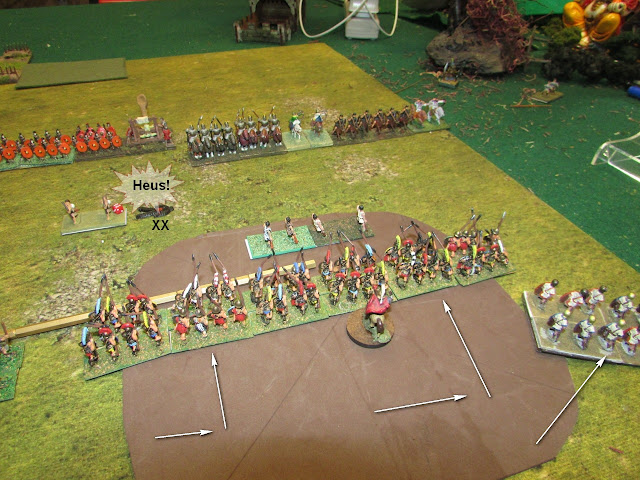 |
On the right, a short advance but maintaining dominance of the hill.
|
Turn 3: |
Rocks fly from the catapults. Hurling over head the Hoplite line.
|
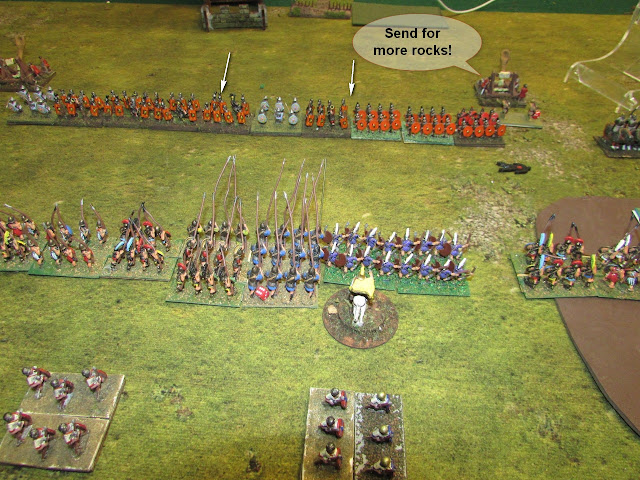 |
Failing to allow for height, the Roman Catapult on their left also is also ineffective
|
 |
Roman horse hesitates at the base of the hill.
|
 |
Oddly, the Greeks are winning the skirmish battle
|
 |
The Greek phalanx marches forward.
|
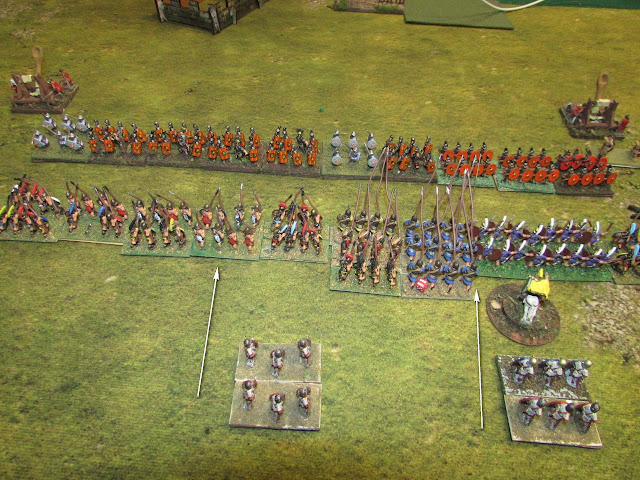 |
Fearless in their ASSumptions.
|
 |
However, the Greek plan assumes they will dominate the edge, then collapse the flanks of the Roman center.
|
And this may be true to a point. On the Greek right, they dominate against the Roman horse, but that is not the same as collapsing the flank.
Turn 4:
 |
After much grunting and repositioning, the catapult finally manages a hit.
|
 |
The legions charge.
|
 |
Winning 6 of 10 fights.
|
 |
Cataphracts advance. Daring the Hoplites to charge.
|
 |
The story at the Tree of Woe is a virtual tie.
|
 |
Lights charge the catapults. But you don't lift 30 mina stones for a living without developing a considerable amount of upper body strength. The crew simply grab the assaulting lights, and hurl them away.
|
 |
Meanwhile, the rest of the Greek plan just falls apart on it's other fallacy. That of holding the line till the flank is turned.
|
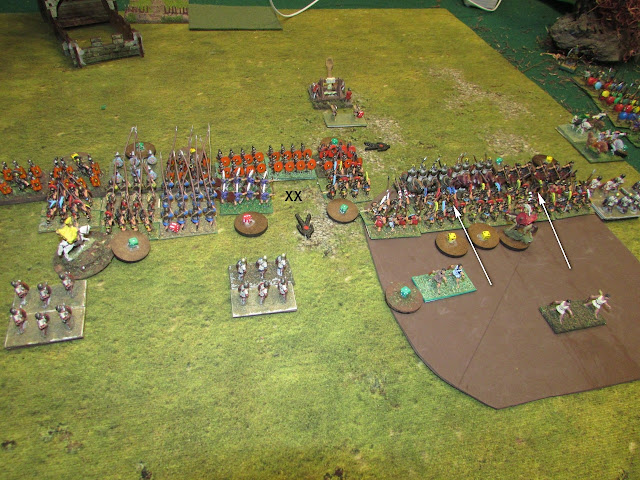 |
Having the hill advantage, but not impact or armor, Davrentios's orders his hoplites to charge.
|
 |
And in half a turn, the score goes from a tie to really bad going.
|
Turn 5: |
Romans advance, penetrating the Greek line.
|
 |
Ditto on the Roman left.
|
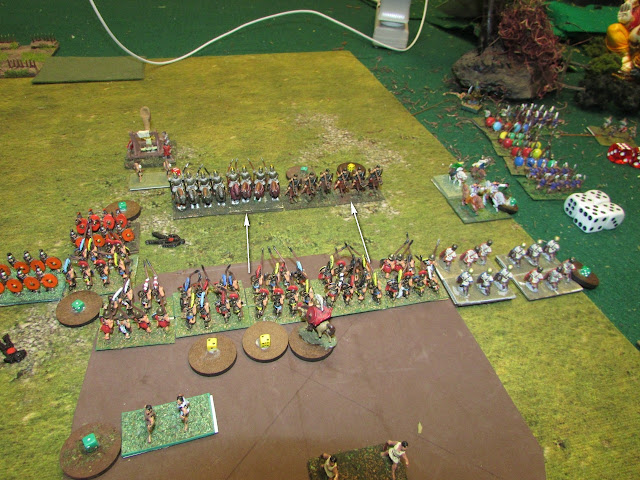 |
The Roman horse disengage. Still denying the flank advantage to the Greeks
|
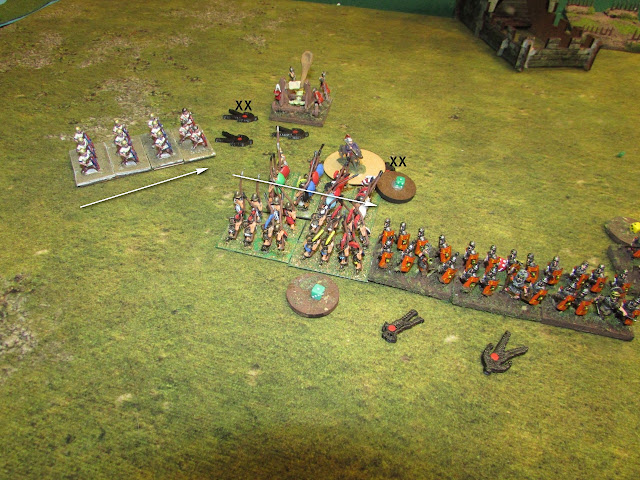 |
Hoplites charge on the flanks! The catapult crew loads some bodies into their engines and send a message to the last of the Greek slingers, who, depart at speed!
|
 |
The last support for the elite hoplites (represented as pike here) falls.
|
 |
| Davrentios offers encouraging words, rallying two of his hoplites. |
|
Probably something like, "Be grateful you aren't those guys!"
 |
The score is 24 of 28 for the Greeks, and 13 of 21 for the Romans
|
Turn 6: |
A Roman Cohort flanks a Greek Hoplite
|
 |
Another Hoplite is flanked, and another!
|
Roman command control at it's finest.
 |
Near the hill, Equites Sagittarii earn their keep.
|
 |
The Greeks offered to surrender, but the offer was refused.
|
 |
Thracians wildly charge the catapult, which holds it's ground
|
 |
One flanked Hoplite falls, the others still stand
|
 |
Equites Sagittarii continue to release volley after volley of arrows.
|
 |
The end is near
|
Turn 7: |
The catapult crew wins another round
|
 |
The Greek Elites in the center win this round as well.
|
 |
But the Romans only need one point, and it can be found anywhere. As it is, it is the Equites Sagittarii that score the final point.
|
The MVP of the game is the Roman Catapult on the right. They destroyed 2 slingers, disordered a Peltast and a Hoplite to one disorder of their own, contributing 6 points to the Roman win.
Overall, the Greek plan was faulty. And then poorly executed. The concept was, that superior numbers, to get on the Roman flanks and then turn on the main body.
The faultiness of the plan was demonstrated on the Greek left. They did have the flank and they did start to eat at the Roman main line. But meanwhile, 2 Peltasts and a Hoplite largely were out of play. The one peltast finally engaged the catapult and lost. But this also means 3 or 4 units were combat ineffective.
On the Greek right, the Roman cavalry prevented and turning of the flank.
Meanwhile the Roman center just ploughed through the Hoplites.
Even if the plan had worked, at most, the Romans would have lost may be 3 more units, not enough for the win.




















































No comments:
Post a Comment